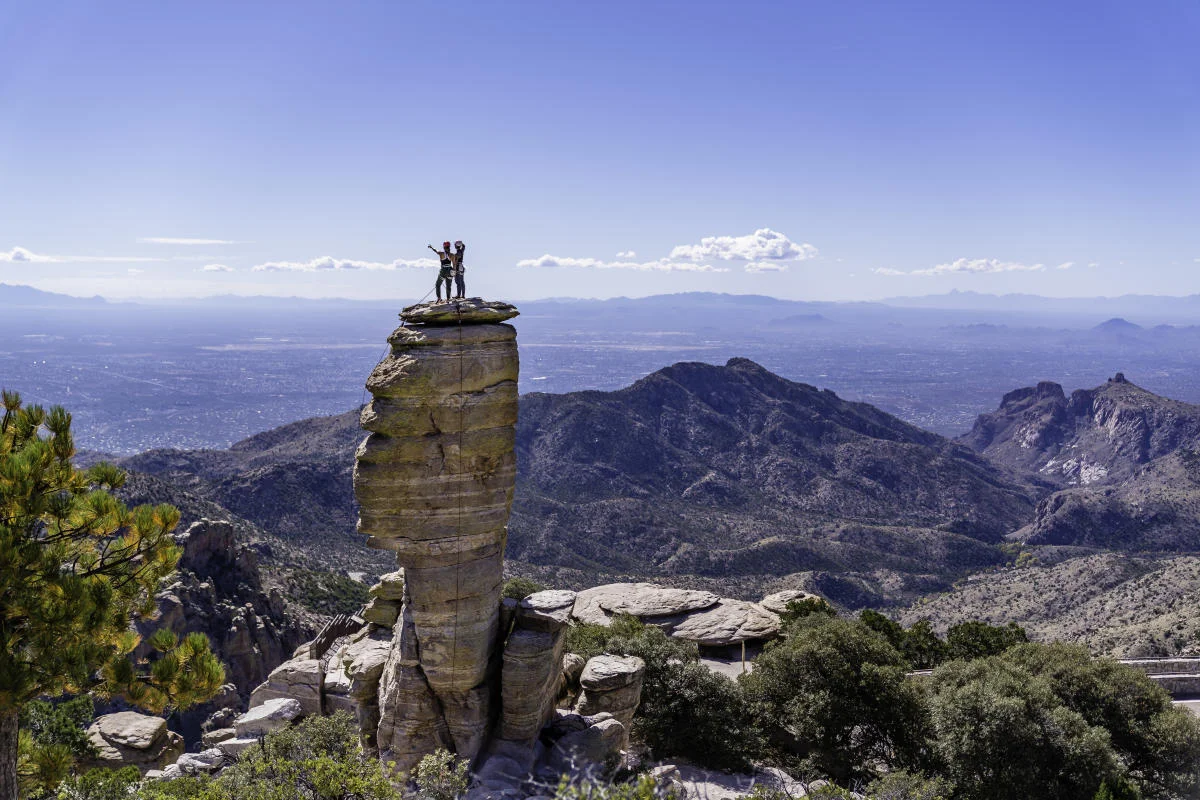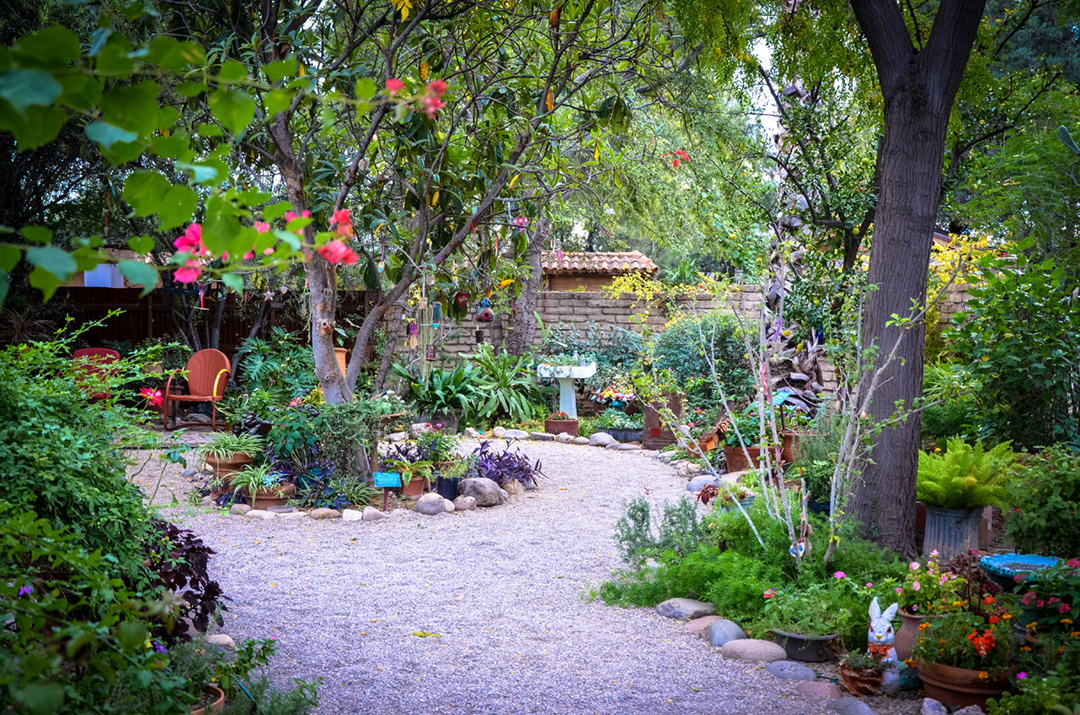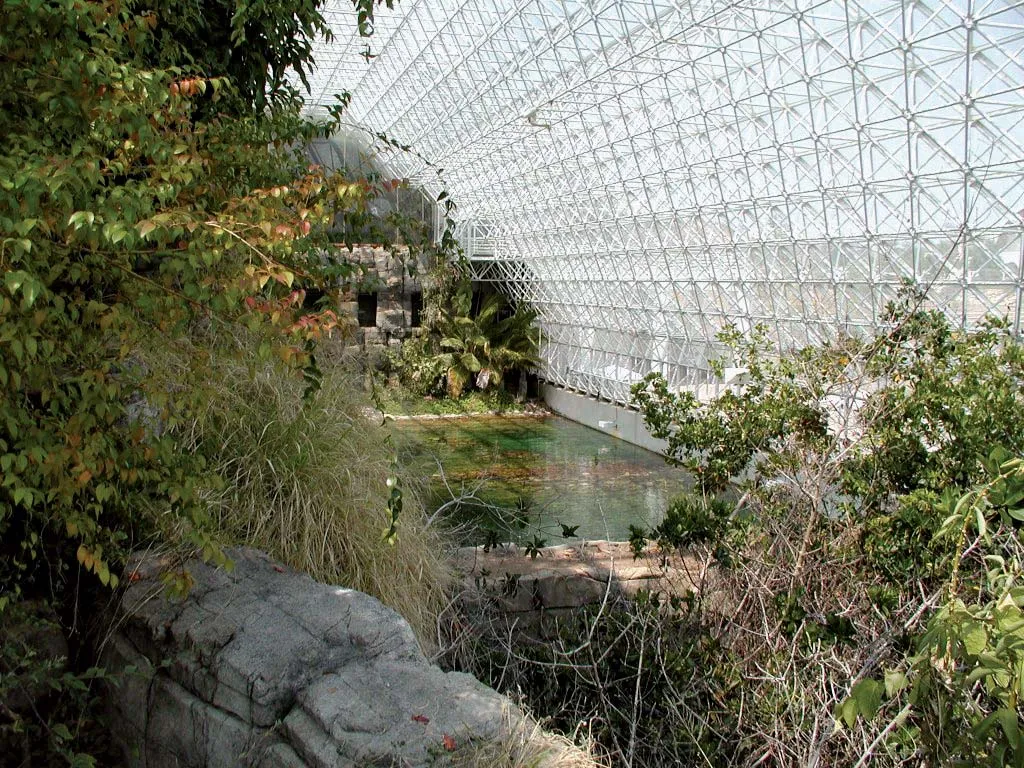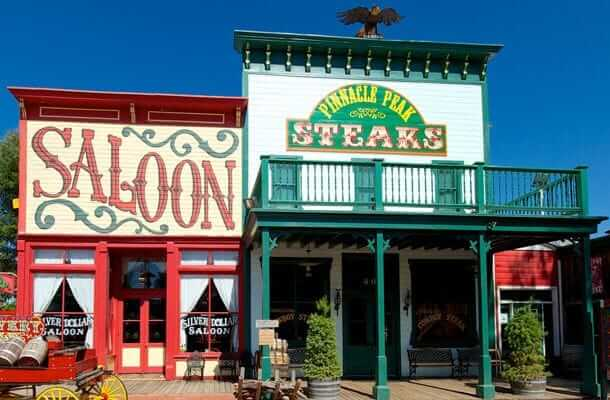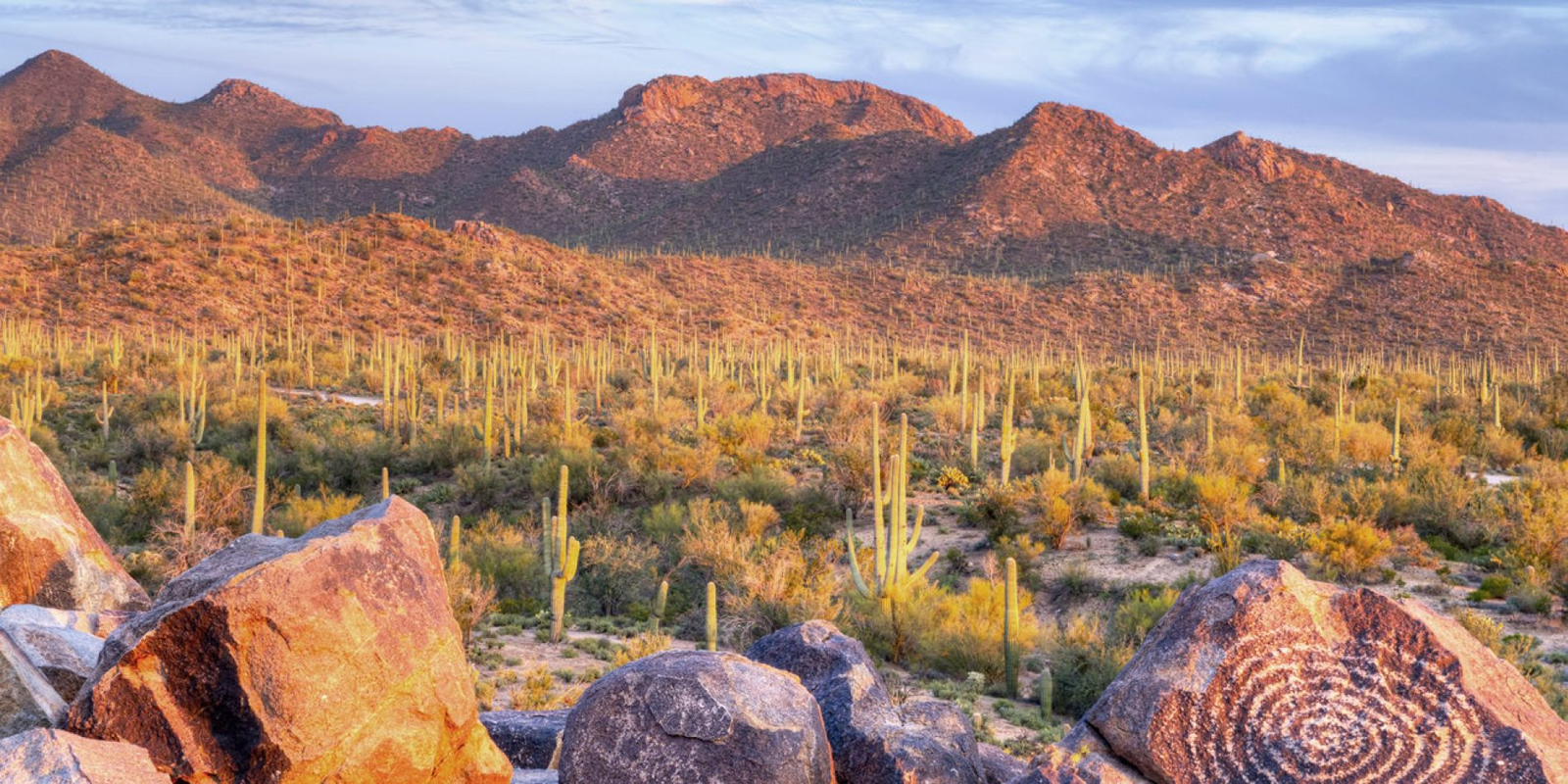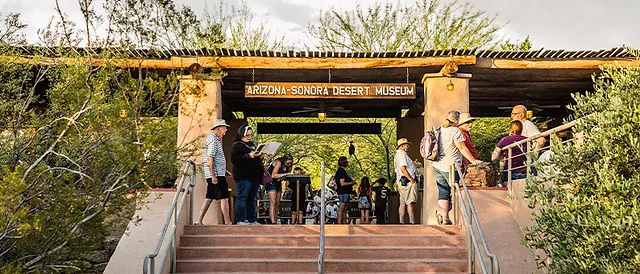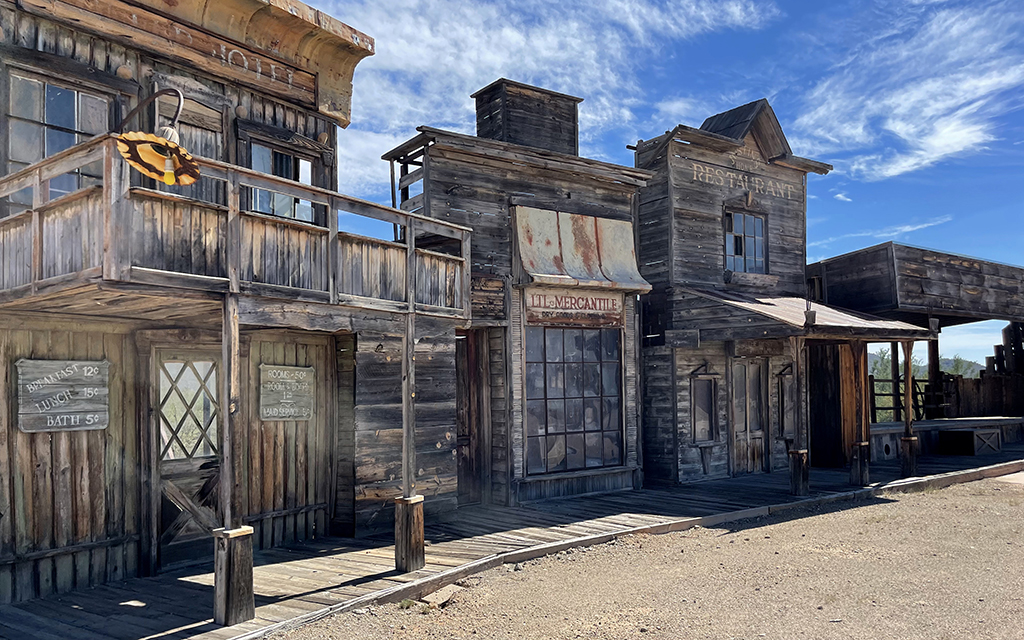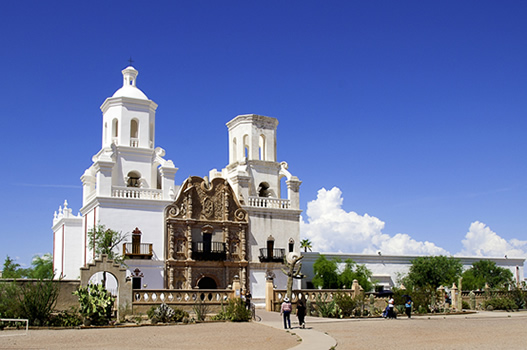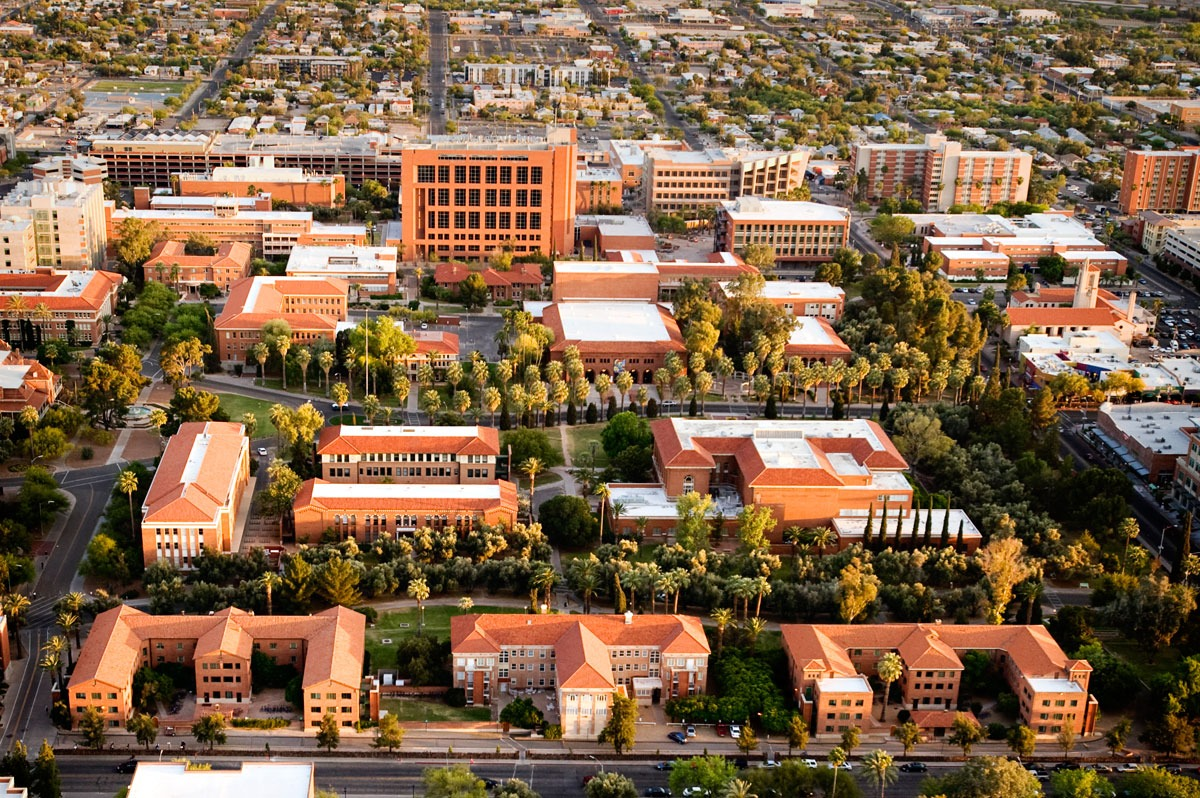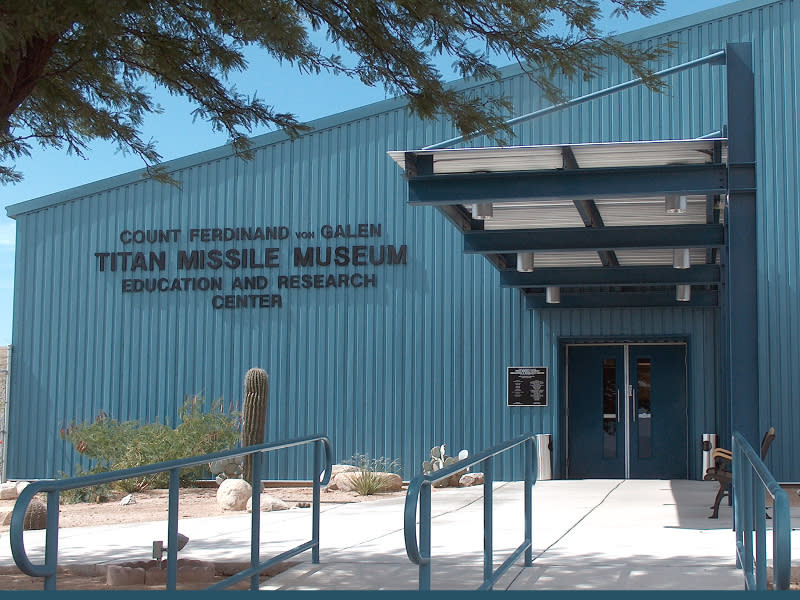Best 12 Attractions in Tucson
Visitors may fill their schedules with a variety of amazing sights in Tucson, which is blessed with bright, sunny weather and breathtaking desert scenery. Arizona’s “Old Pueblo” offers a variety of activities, from admiring cactus at famous parks to touring museums dedicated to ancient history, learning about cutting-edge art scenes, and savoring delectable Southwest food.
This list highlights 12 of Tucson’s top attractions drawing nature lovers, culture vultures, foodies and outdoor adventurers alike under its clear blue skies.
Best 12 Attractions in Tucson (2025)
Tucson Botanical Gardens
Name and Location: Tucson Botanical Gardens is a picturesque urban garden located downtown, showcasing regional plants from the Sonoran Desert and around the world.
History and Significance: Originally begun in the 1960s by citizens protecting endangered cacti, the garden has grown into an acclaimed public space supporting plant conservation.
What to Expect: Visitors walk through a variety of themed garden exhibits like the Cactus and Succulent Garden, Herb Garden, Butterfly Garden and more. Seasonal events, classes and exhibitions are also offered.
Visitor Information: The gardens are open year-round except major holidays, charging an entrance fee. Amenities include gift shop, café, and library. Wheelchair accessible.
Located on five acres, the family-friendly Tucson Botanical Gardens offers colorful tranquility close to the toe-sloping Santa Catalina Mountains along the Rillito River bike route. With more than a dozen installations interwoven with desert trees, flower arrangements, and even fanciful fairy doors nestled among granite rocks, the Porter Sculpture Garden is a delightful place to visit. From October through March, up to 2000 fluttering wings glide by guests in the stunning Butterfly Magic display, which is housed in a temperature-controlled greenhouse.
Other gardens have native desert plants with labels, such as barrel cactus and dry-climate palms from all continents. When strolling through the perfumed grounds, guests are always drawn to the onsite art galleries, gift shops, outdoor dining areas, and regular music events. Tucson Botanical Gardens is a top indoor/outdoor activity for an urban retreat that celebrates local environment through art and science.
Biosphere 2
Name and Location: Biosphere 2 is a unique research site and public science center focused on the study of sustainable living systems, located about 30 miles north of Tucson, Arizona.
History and Significance: Originally built in the 1990s for closed ecological experiments, today Biosphere 2 runs climate change research projects using the sprawling glass-enclosed laboratory. Tours educate visitors about earth systems science.
What to Expect: Guests can take a guided walking tour through Biosphere 2’s exotic huge enclosed landscapes, once home to research teams. Exhibits cover experiments, wilderness conservation, and space colonization.
Visitor Information: Biosphere 2 requires timed-entry tickets for tours. Guests should plan on a minimum 2-hour visit. The site includes a gift shop/café. Budget extra driving time to reach this unique attraction.
Originally a Columbia University-run experimental enclosed human habitat, Biosphere 2 is now a distinctive attraction run by the University of Arizona. The expansive glass-covered complex offers guided walking tours through the biomes of savannah grassland, coastal fog desert, and tropical rainforest, which were occupied by scientific personnel in environmental isolation between 1991 and 1993.
The legacy of the Biosphere 2 project is chronicled by expanded museum exhibits that highlight findings that continue to impact sustainability research in areas ranging from food production to water recycling. Heirloom crops from three different Native American agricultural civilizations are grown in the on-site ethnobotanical garden, and monthly full moon adventure tours provide unique access after hours. Biosphere 2 is a very remarkable addition to any Tucson itinerary, offering unique insights into the ambitious science underlying spaceship Earth.
Sabino Canyon Recreation Area
Name and Location: Sabino Canyon Recreation Area is a popular natural preserve located minutes from Tucson, Arizona in the Santa Catalina Mountains, managed by the US Forest Service.
History and Significance: Settled by Native Americans, then miners, ranchers and homesteaders, today it invites respectful recreational use. Sabino Creek supports a rare perennial desert stream.
What to Expect: Visitors can walk, hike or take a tram tour to explore the canyon. Highlights include seven miles of creek, waterfalls, desert landscapes and plentiful wildlife along the trails.
Visitor Information: The recreation area is open year-round with a per-vehicle fee. Services include visitor center, tram tours, restaurant, gift shop and restrooms.
The Sabino Canyon Recreation Area, located 15 minutes northeast of Tucson, transports tourists to breathtaking high desert landscapes, with jagged Santa Catalina peaks framing sandy Sonoran Desert canyonlands sculpted by Sabino Creek. Riding the 45-minute narrated Sabino Canyon Tram, which travels more than 3 miles into the foothills past groves of saguaro cacti and cascading waterfalls over desert stone, is the park’s main attraction.
Active explorers can disembark halfway and hike downwards. Some trails pass petroglyph boulders or the remains of a historic dam, while the moderate Bear Canyon Trail spans the creek to a swimming spot. With miles of trails suitable for all skill levels and easy access to trailheads, Sabino Canyon has plenty to offer every outdoor lover.
Pima Air & Space Museum
Name and Location: Pima Air & Space Museum displays civilian and military aircraft from around the world. It is located adjacent to Davis-Monthan Air Force Base in Tucson, Arizona.
History and Significance: Founded in 1976, it houses an acclaimed collection of over 300 aircraft, including many rare and one-of-a-kind flown in historic events. As the largest non-government funded air museum, it depends on visitor support.
What to Expect: Guests can explore hangars full of aircraft and related exhibits. Highlights include Presidential planes, WWII planes, experimental aircraft, and cockpits you can climb into. Guided tram and walking tours are available.
Visitor Information: The museum is open daily year-round, closing only Thanksgiving and Christmas. An entrance fee supports its mission. Visitor services include cafeteria, gift shops and shaded outdoor picnic area.
The Pima Air & Space Museum, which is located next to Davis-Monthan Air Force Base and spans 80 acres, is home to 300 aircraft and spacecraft, making it one of the largest collections in the world. Spend at least half a day seeing hangars and outdoor exhibits that feature everything from a replica flyer made by the Wright brothers to contemporary spy aircraft such as the SR-71 Blackbird.
While flight simulators allow tourists to practically pilot planes, knowledgeable docents provide insider flying anecdotes during tram tours. Local Tucson artists such as astronaut Frank Borman and conceptual artist Robert McCall, dubbed the “father of the Mother Ship,” are featured in the exhibits. From the heyday of early barnstorming to the optimistic dreams of commercial space flight, the museum’s breathtaking displays leave a lasting impression.
See also: Top 12 Best Restaurants in Mesa
Trail Dust Town
Name and Location: Trail Dust Town is an recreated 1880s style Wild West town and theme park located in Tucson, Arizona.
History and Significance: Built in 1960, Trail Dust Town entertains visitors with stunt shows, train robbery reenactments, cowboy cookouts, wagon rides, saloon entertainment, shops and more. Guests enjoy family-friendly Wild West fun.
What to Expect: Visitors can explore the wooden boardwalk streets past historic buildings filled with shops and eateries. Entertainment includes musical shows like the Trail Dust Melodrama, a stunt show, and the miniature Trail Dust Train.
Visitor Information: Trail Dust Town is open daily year-round charging an entrance free. Guests can pay for add-ons like train rides and cowboy cookouts. Free parking on-site.
In southeast Tucson, this restored 1880s frontier town offers family-friendly entertainment, carnival rides, stunt shows, and historical attractions spread across 65 acres decorated in the Old West. Visitors can pan for gold, ride the antique carousel, play mini golf, or boot scoot across the dancehall floor, and every evening at dusk, actors perform exciting Wild West stunt shows complete with bank robberies, cancan dancers, and thundering horses circling the dusty streets with guns blazing.
Low-key museums document Southern Arizona mining and ranching history with antique equipment and an assay office. There are also plenty of shopping options, including 20+ boutiques and restaurants, including the excellent Pinnacle Peak Steakhouse.
Tohono Chul Botanical Gardens
Name and Location: Tohono Chul Botanical Gardens is a lush desert garden paradise located in northwest Tucson, Arizona. It focuses on native plants from the Sonoran Desert region.
History and Significance: Since founding in 1985, Tohono Chul has grown into a respected botanical garden, art gallery, and cultural center representing the heritage of the Sonoran Desert and the Tohono O’odham people native to the region.
What to Expect: Visitors can wander through cultivated gardens, wildflower meadow, demonstration gardens, and exhibits integrating native plants and art. The grounds also contain a teahouse, gift shop, and gallery.
Visitor Information: Tohono Chul is open year-round except major holidays, charging an entrance fee. An on-site bistro provides refreshments. Regularly scheduled cultural, art and nature-based events occur.
Tohono Chul Botanical Gardens, which spans 49 acres in north Tucson, honors Southern Arizona’s cultural legacy while showcasing a variety of desert landscaping. Nature pathways meander past displays of wildflowers and cacti, as well as tranquil fountains and water features that evoke the Spanish Colonial design found in mission churches throughout the region. Alongside Hispanic retablos paintings that are rich in Catholic imagery, galleries display Native American artwork such as Hopi Katsina dolls and jewelry.
While regular demonstrations showcase local traditions like native basketweaving utilizing natural materials like yucca fibers, two on-site eateries serve cuisine originating from the surrounding desert. Tohono Chul stresses the responsible use of valuable desert resources, such as uncommon Baja Arizona plants, in all of its exhibitions. Tohono Chul offers valuable insights for both indoor and outdoor experiences with the distinctive natural and cultural heritage of the Sonoran Desert.
Saguaro National Park
Name and Location: Saguaro National Park is located in southern Arizona, with districts on either side of Tucson. The park was created to protect the iconic saguaro cactus that thrives in the Sonoran Desert landscape.
History and Significance: Saguaro National Park was established in 1994, combining the previously designated Saguaro National Monument established in 1933 with additional land. The saguaro is a key part of the ecological community and sacred to native peoples. The park protects these majestic cacti and the unique desert habitat.
What to Expect: Visitors can hike, bike or ride horseback through saguaro forests and admire exceptional desert scenery and wildlife. Popular activities include ranger-led programs, camping, and photography of the scenic saguaros at sunset.
Visitor Information: The park is open year-round with an entrance fee of $25 per vehicle. Visit the Red Hills or Rincon Mountain districts, depending on which side of Tucson you’re on. Be prepared for remote desert hiking.
A trip to Tucson wouldn’t be complete without seeing the majestic saguaro cactus, and Saguaro National Park, which preserves the unique habitat of the Sonoran Desert, offers the best access. The city is surrounded by two sections of the park. Hiking amid the namesake cacti and taking in breathtaking sunsets is possible in the tiny Rincon Mountain District, which is located east of town.
Hikers, horseback riders, and mountain bikers can enjoy fantastic saguaro sightings over 165 miles of trails in the Tucson Mountain District, which is located west of the city. For observing species that favor preserved desert wilderness, birders value both districts. Devoted birders identify more than 200 species, ranging from little cactus wrens to magnificent great horned owls. Saguaro National Park is one of Tucson’s most visited destinations because of the saguaro, which is a common symbol of the area.
Arizona-Sonora Desert Museum
Name and Location: The Arizona-Sonora Desert Museum is a world-renowned zoo, natural history museum and botanical garden located just west of Tucson, Arizona.
History and Significance: Founded in 1952, it features plants and animals native to the Sonoran Desert. It is dedicated to interpreting the natural history of the region while promoting conservation. The museum is an acclaimed model for zoos around the world.
What to Expect: Visitors can explore recreated desert habitats with plants and wildlife on walking paths and exhibits. Highlights include the hummingbird aviary, Sonoran Desert habitat dioramas, and animal shows/talks.
Visitor Information: The museum is open year-round except Thanksgiving/Christmas. Admission fees apply. Plan to spend at least half a day. Visitor amenities include a café, gift shops, and an art gallery.
The unique Arizona-Sonora Desert Museum, located on 98 acres west of downtown, combines a zoo, a natural history museum, and floral garden attractions. Visitors may get a close-up look at the Sonoran Desert’s varied fauna, which includes elegant bighorn sheep and playful coatis, in wildlife enclosures.
Walking trails meander among local plant displays, such as a remarkable cactus garden that houses rare varieties. The museum’s mineralogy exhibits, art gallery, and reptile house all explain the natural wonders of the desert. Animal training, raptors’ free flight, and indigenous crafts like Tohono O’odham basket weaving are frequently showcased in demonstrations. The Arizona-Sonora Desert Museum is one of the best attractions of its kind in North America, with captivating sights that are sure to both fascinate and educate.
Old Tucson Studios
Name and Location: Old Tucson Studios is a Western-themed attraction located just west of Tucson, Arizona. It was originally built as a film set for Hollywood westerns.
History and Significance: Created in 1939 for the movie Arizona, it continued to be used for filming through the 1980s. Stars like John Wayne and Clint Eastwood acted there. It later opened for public tours and events.
What to Expect: Visitors can explore the historic movie studio buildings on guided or self-guided tours. Costumed actors perform shows and reenactments of scenes. Other attractions include stagecoach rides, cowboy stunt shows and living history demonstrations.
Visitor Information: Old Tucson is open year-round charging an entrance fee. Special evening events are also held. Amenities include gift shops, saloon, and on-site restaurant.
Old Tucson Studios was used to film outdoor scenes for classic Hollywood Westerns including John Wayne’s “Rio Bravo” and “El Dorado.” This family attraction, which was first built in 1939, features daily entertainment and a recreation of a real frontier village. Among the activities available to visitors are shootout stunt shows, vintage steam train rides, gold panning, blacksmith demonstrations, and interactions with cancan dancers and other Wild West entertainers.
Many of the wooden structures from previous film heydays, which included Glenn Ford and Steve McQueen, are still standing. Every year, the arena hosts one or two professional rodeas featuring bull riding, roping, and bronco riding. Old Tucson Studios provides big dusty fun for all ages, with echoes of Tombstone’s renowned past mixed with Hollywood nostalgia.
Mission San Xavier del Bac
Name and Location: Mission San Xavier del Bac is a historic Spanish Catholic mission located about 10 miles south of downtown Tucson, Arizona on the Tohono O’odham San Xavier reservation.
History and Significance: The Mission was founded by Jesuit missionary Eusebio Kino in 1692, making it the oldest European structure in Arizona. Its elegant white adobe architecture with Moorish accents has earned it the nickname “White Dove of the Desert.”
What to Expect: Visitors can tour the historic church with its intricate interior decorations or attend Mass. The site’s museum documents its history. The Mission hosts annual events celebrating its heritage.
Visitor Information: The Mission is open daily to visitors year-round. Guided tours are available for a fee. Respectful attire is required and photos inside are not permitted.
Situated just off I-19 and 10 miles south of downtown, the white-domed Mission San Xavier del Bac is arguably Tucson’s most recognizable building. In 1700, Padre Eusebio Kino, a Jesuit missionary, built a church here for the Tohono O’odham tribe. The graceful building in the Mexican Baroque style was built in 1783 and later embellished with Spanish and Moorish elements. The interior of the mission, which was magnificently refurbished in the 1990s, is dazzling with original murals and statues.
With Sunday masses that combine ritual aspects from traditional O’odham and Catholic faiths, the mission continues to actively serve tribal members in the San Xavier District. The history of the mission and Kino’s legacy throughout what is now Northern Mexico and Southern Arizona are chronicled in a small museum. Over two centuries of intriguing Tucson history are embodied in Mission San Xavier del Bac, which boasts amazing architecture set against breathtaking desert surroundings.
University of Arizona Campus
Name and Location: The University of Arizona is a major public research university located in central Tucson. It is the oldest university in the state, founded in 1885. The campus contains many historic buildings.
History and Significance: With over 44,000 students today, the UA campus houses acclaimed programs and faculties active in scientific research. Its Desert Lab furthers the study of arid lands. Historic architecture conveys its long legacy educating Arizona’s citizens.
What to Expect: Visitors can explore the campus by walking or using the free streetcar line. Highlights include the historic district, Arizona State Museum, Center for Creative Photography, Biosphere 2 exhibits, astronomy shows at UA SkyCenter, and performing arts events.
Visitor Information: Guests can access much of campus year-round for self-guided tours. Paid parking is available across campus. Visitor services are mainly concentrated along University Blvd. Guided tours may require reservations.
The 380-acre main campus of the University of Arizona in central Tucson has excellent walking grounds and world-class museums that are open to everyone for free. With an outstanding Hopi collection, the Arizona State Museum features items from the area’s first human settlers to modern Native Americans. Outside Percy L. Julian’s namesake chemistry building, a monument of Kokopelli in a gown pays homage to the scientist’s groundbreaking work.
Through readings, print material archives, and audio-visual materials, the UA Poetry Center honors the spoken and written arts. The planetarium programs and mineralogy curiosities of the Flandrau Science Center are more fanciful entertainment options. On campus, public artworks such as the majestic bronze statue of the Abstract Wildcat by artist Joe O’Connell beckon. The varied attractions of the University of Arizona provide a quick flavor of Tucson’s dynamic nature and respect for its cultural heritage stewards.
Titan Missile Museum
Name and Location: The Titan Missile Museum is a preserved Titan II nuclear missile site located 25 miles south of Tucson, Arizona. It is a National Historic Landmark.
History and Significance: An operational Titan II missile base during the Cold War, today it represents histories of space exploration and mutually assured destruction policies. It is the only Titan missile complex accessible to public visits.
What to Expect: Visitors tour the underground missile silo and control room to grasp the enormity of nuclear intercontinental ballistic missile systems, set within wider histories. Displays cover related science, space, and military history.
Visitor Information: The museum leads guided tours of this secure federal site. Reservations required for entry. Closed Thanksgiving and Christmas. Gift shop on-site. Budget driving time as the site is remote.
The Titan Missile Museum offers a rare look at America’s former subterranean nuclear warhead infrastructure, making it a genuinely unique Cold War monument. Small groups are given hour-long excursions that take them inside the Titan II ICBM silo complex’s command center, which was formally deactivated in 1982. See code-to-arm systems, switch panels from the 1960s, and the massive retired missile that is still horizontally positioned in its launch duct.
Key training, communication networks, and procedures supporting Titan II operations throughout MAD-driven decades of remote desert missile crew deployments are explained by expert advisers. Surface displays also include uncrewed space rocket versions that have been launched in the area for decades to transport NASA missions and satellites. This National Historic Landmark, the only Titan base open to the public, highlights sobering military technology that advances the Space Race and protects Pax Americana.
Reid Park Zoo
Name and Location: Reid Park Zoo is a mid-sized zoo located within city-owned Reid Park in Tucson, Arizona. It displays exotic animals from around the world.
History and Significance: Founded in 1967, the zoo has focused on animal conservation efforts, education and enhanced exhibits over time. Special highlights include the giant anteaters and Komodo dragon on display.
What to Expect: Visitors can explore zoo grounds viewing tropical animals like rhinos/giraffes, Australian animals like wombats/kangaroos, a South American rainforest habitat, and more flightless birds, big cats, primates and reptiles.
Visitor Information: Reid Park Zoo is open daily except major holidays, charging an admission fee. Amenities include gift shop, on-site food options, and shaded sitting areas. Stroller/wheelchair rental available.
The Reid Park Zoo, which occupies a small but densely populated area in the heart of Reid Park next to Broadway Boulevard, dazzles guests with well-designed displays that are teeming with a variety of animals, including towering giraffes, roaring lions, playful otters, and other beloved animals. Lemur islands by the creek, flamingo lagoons, and large elephant and rhino paddocks with instructive activities and stories regularly posted are all along shaded walks.
Plans for active expansion place a strong emphasis on innovative immersion experiences that use bio-dome areas and free-flight aviaries to take visitors to tropical Asian and South American settings. The zoo’s hidden, peaceful location in the heart of the city serves to inform and motivate aspiring environmentalists until new exhibits debut in the upcoming years.
Conclusion
Tucson’s attractions, which range from breathtaking sunsets over saguaro sentinels to thrilling rollercoasters scream past old movie sets, perfectly capture the city’s friendly vibe anchored in amazing natural settings. Both innovative scientific hubs like Biosphere 2 and Spanish-influenced architectural wonders like San Xavier Mission offer visitors a taste of culture. Great local cuisine, always prepared in Tucson flair, shares the stage with family-friendly animal experiences at the Reid Park Zoo and the Arizona-Sonora Desert Museum. While the University of Arizona’s updated campus advances international research that benefits all of humanity, tours of rustic dude ranches transport visitors back to the Arizona Territory’s earlier days. This list highlights the Old Pueblo’s joyful ability to combine state-of-the-art programming with friendly hospitality and respect for its distinctive borderlands past, offering a sampling of experiences as varied as Tucson itself.
